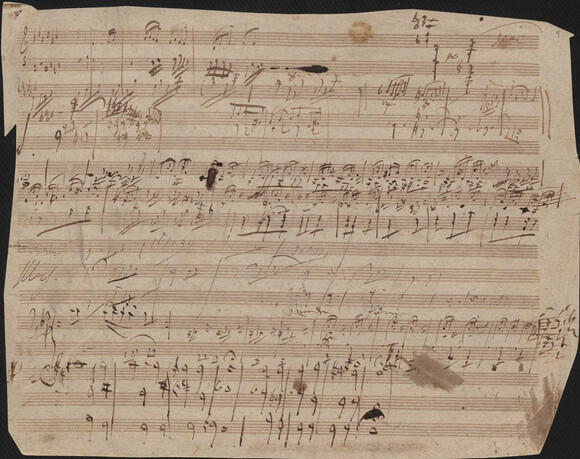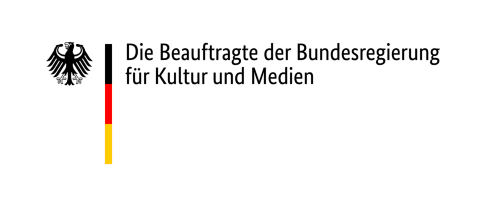Music
2020 will see the 250th anniversary of Ludwig van Beethoven. To mark the anniversary there will be exhibitions, concerts, conferences, workshops and further events in Germany and around the globe. The music of Beethoven is among the most frequently performed works of classical music. Especially his Ninth Symphony with words from Schiller's "Ode to joy" has its own history: both as official hymn of the Council of Europe and as political-artistic performance in the year 1989 after the Fall of the Berlin Wall when Leonard Bernstein changed the text sung to "Freiheit, schöner Götterfunken" (Liberty, beautiful spark of divinity) in the final movement of the symphony. It is a history which continues to be written to this day.
Among the numerous memory institutions which will be active in the Beethoven anniversary year there is also the music department of the Staatsbibliothek zu Berlin, which plans an exhibition with autograph items such as music autographs, sketches, conversation books, letters, and documents. The presentation is complemented by other exhibits such as first and early printings of Beethoven's works as well as engravings and portraits related to the composer of the Viennese Classic. The library preserves a very comprehensive Beethoven collection, 50% of which are extant autographs. The collection includes the piano concerts Nos. 1-3 and 5, the opera Fidelio, the Missa solemnis and the symphonies Nos. 4, and 5, large parts of the Eighth, as well as the Ninth Symphony, which in 2001 was included in the UNESCO-Register "Memory of the World".Beethoven recorded his musical ideas and conceptions in so-called sketchbooks, which have also been preserved in Berlin - a unique case in the history of music, because normally composition sketches were either destroyed after completion of the work or have not survived for various reasons.
In a very special way these sketchbooks illustrate how Beethoven worked: They often document very early stages of the origin and the development of a musical idea as well as compositional difficulties occurring during the process of creation.
In order to support the preparations of the anniversary year the SBB will catalogue online and digitise the Beethoven collection items, the project is made possible thanks to the financial support of the Beauftragte der Bundesregierung für Kultur und Medien (The Federal Government Commissioner for Culture and the Media). To date the holdings are catalogued in printed catalogues: In 1970, on the occasion of the last great Beethoven anniversary, the music department of the Deutsche Staatsbibliothek (East) edited a directory of all their Beethoveniana (Eveline Bartlitz: Die (Ludwig van) Beethoven-Sammlung in der Musikabteilung der Deutschen Staatsbibliothek. Verzeichnis der Autographe, Abschriften, Dokumente, Briefe, Berlin 1970) and in 1975 the music department of the Staatsbibliothek Preußischer Kulturbesitz (West) published the equivalent directory in the context of their catalogue series (Hans-Günter Klein: Ludwig van Beethoven. Autographe und Abschriften. Katalog, Berlin 1975 (Staatsbibliothek Preußischer Kulturbesitz, Kataloge der Musikabteilung, Erste Reihe: Handschriften, 2).
In the course of the project music autographs and sketches were included in the database RISM, letters of the composer as well as personal documents and the 137 conversation books, those of relevance for biographical research - two more are held in the Beethoven-Haus in Bonn - are catalogued in Kalliope. Beethoven's own entries in the conversation books are comparatively rare, the majority of the entries were jotted down by friends and visitors. This was necessary for communicating with the composer who had become completely deaf in 1819. When the project is finished, around 17,500 pages of autograph works of Ludwig van Beethoven will be searchable online. They can be consulted free of charge on the library's Digitised Collections.
Before the Beethoven anniversary year starts, the library will include around 1,000 title records of one of the worldwide most complete collections of Beethoven's first and early prints (until around 1830) in their online catalogue.
As the autographs are of special importance for musicological research, paper characteristics will play an important role in the project: Using the modern technology of thermography, paper watermarks are digitised and made accessible online in the special database "Wasserzeichen-Informationssystem" [watermark information system] of the Landesarchiv Baden-Württemberg. For the extraction, identification and processing of watermarks in music autographs the library uses best practices, which have been well proven in two projects: "Bachs Werkautographen" Bach's autograph works", which was also funded by the BKM, and the DFG project "Kompetenzzentrum Forschung und Information Musik = KoFIM Berlin" (competence centre research and information music).
The goal of the project is to provide online high-quality catalogue records of the extremely valuable holdings, which are essential for musicology. At the same time important Beethoven collections will be prepared for the exhibition in the anniversary year 2020. This exhibition, which will coincide with an exhibition planned by the Beethoven-Haus and the Bundeskunsthalle Bonn, is the first presentation of Beethoven materials of the Staatsbibliothek zu Berlin since German reunification. In a few years on the occasion of Beethoven's 250th anniversary year there will be a joint presentation of the collections formerly divided between the Deutsche Staatsbibliothek and the Staatsbibliothek Preußischer Kulturbesitz.
![L. v. Beethoven, Fidelio - eine große Oper in 2 Aufzügen, [title page of the Harmony Music arranged for 9 voices by Wenzl Sedlak], Wien Artaria [1814], Shelfmark: DMS 13509](/fileadmin/_processed_/5/d/csm_Fidelio-Titelblatt-k_a268ae57b7.jpg)


